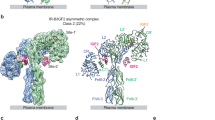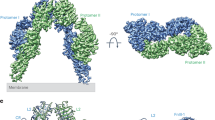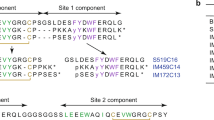Abstract
Insulin receptor (IR) signaling controls multiple facets of animal physiology. Maximally four insulins bind to IR at two distinct sites, termed site-1 and site-2. However, the precise functional roles of each binding event during IR activation remain unresolved. Here, we showed that IR incompletely saturated with insulin predominantly forms an asymmetric conformation and exhibits partial activation. IR with one insulin bound adopts a Γ-shaped conformation. IR with two insulins bound assumes a Ƭ-shaped conformation. One insulin binds at site-1 and another simultaneously contacts both site-1 and site-2 in the Ƭ-shaped IR dimer. We further show that concurrent binding of four insulins to sites-1 and -2 prevents the formation of asymmetric IR and promotes the T-shaped symmetric, fully active state. Collectively, our results demonstrate how the synergistic binding of multiple insulins promotes optimal IR activation.
This is a preview of subscription content, access via your institution
Access options
Access Nature and 54 other Nature Portfolio journals
Get Nature+, our best-value online-access subscription
$29.99 / 30 days
cancel any time
Subscribe to this journal
Receive 12 print issues and online access
$189.00 per year
only $15.75 per issue
Buy this article
- Purchase on Springer Link
- Instant access to full article PDF
Prices may be subject to local taxes which are calculated during checkout







Similar content being viewed by others
Data availability
All reagents generated in this study are available with a completed Materials Transfer Agreement. All cryo-EM maps and models reported in this work have been deposited into EMDB/PDB database, under the entry ID: EMD-25188/PDB 7SL1, EMD-25189/PDB 7SL2, EMD-25190/PDB 7SL3, EMD-25191/PDB 7SL4, EMD-25192/PDB 7SL6, EMD-25193/PDB 7SL7, EMD-25428/PDB 7STH, EMD-25249/PDB 7STI, EMD-25430/7STJ and EMD-25431/7STK. Source data are provided with this paper.
References
Haeusler, R. A., McGraw, T. E. & Accili, D. Biochemical and cellular properties of insulin receptor signalling. Nat. Rev. Mol. Cell Biol. 19, 31–44 (2018).
Ullrich, A. et al. Human insulin receptor and its relationship to the tyrosine kinase family of oncogenes. Nature 313, 756–761 (1985).
White, M. F. Insulin signaling in health and disease. Science 302, 1710–1711 (2003).
Boucher, J., Kleinridders, A. & Kahn, C. R. Insulin receptor signaling in normal and insulin-resistant states. Cold Spring Harb. Perspect. Biol. 6, a009191 (2014).
Petersen, M. C. & Shulman, G. I. Mechanisms of insulin action and insulin resistance. Physiol. Rev. 98, 2133–2223 (2018).
Olefsky, J. M. The insulin receptor: its role in insulin resistance of obesity and diabetes. Diabetes 25, 1154–1162 (1976).
Lawrence, M. C. Understanding insulin and its receptor from their three-dimensional structures. Mol. Metab. 52, 101255 (2021).
De Meyts, P. Insulin/receptor binding: the last piece of the puzzle? What recent progress on the structure of the insulin/receptor complex tells us (or not) about negative cooperativity and activation. Bioessays 37, 389–397 (2015).
Ferguson, K. M., Hu, C. & Lemmon, M. A. Insulin and epidermal growth factor receptor family members share parallel activation mechanisms. Protein Sci. 29, 1331–1344 (2020).
McKern, N. M. et al. Structure of the insulin receptor ectodomain reveals a folded-over conformation. Nature 443, 218–221 (2006).
Scapin, G. et al. Structure of the insulin receptor–insulin complex by single-particle cryo-EM analysis. Nature 556, 122–125 (2018).
Gutmann, T., Kim, K. H., Grzybek, M., Walz, T. & Coskun, U. Visualization of ligand-induced transmembrane signaling in the full-length human insulin receptor. J. Cell Biol. 217, 1643–1649 (2018).
Weis, F. et al. The signalling conformation of the insulin receptor ectodomain. Nat. Commun. 9, 4420 (2018).
Uchikawa, E., Choi, E., Shang, G., Yu, H. & Bai, X. C. Activation mechanism of the insulin receptor revealed by cryo-EM structure of the fully liganded receptor–ligand complex. eLife 8, e48630 (2019).
Gutmann, T. et al. Cryo-EM structure of the complete and ligand-saturated insulin receptor ectodomain. J. Cell Biol. 219, e201907210 (2020).
Kristensen, C. et al. Alanine scanning mutagenesis of insulin. J. Biol. Chem. 272, 12978–12983 (1997).
Schaffer, L. A model for insulin binding to the insulin receptor. Eur. J. Biochem. 221, 1127–1132 (1994).
De Meyts, P. & Whittaker, J. Structural biology of insulin and IGF1 receptors: implications for drug design. Nat. Rev. Drug Discov. 1, 769–783 (2002).
Bai, X. C., Rajendra, E., Yang, G., Shi, Y. & Scheres, S. H. Sampling the conformational space of the catalytic subunit of human gamma-secretase. eLife 4, e11182 (2015).
Li, J. et al. Cryo-EM analyses reveal the common mechanism and diversification in the activation of RET by different ligands. eLife 8, e47650 (2019).
Ciszak, E. & Smith, G. D. Crystallographic evidence for dual coordination around zinc in the T3R3 human insulin hexamer. Biochemistry 33, 1512–1517 (1994).
Kavran, J. M. et al. How IGF-1 activates its receptor. eLife 3, e03772 (2014).
Xu, Y. et al. How ligand binds to the type 1 insulin-like growth factor receptor. Nat. Commun. 9, 821 (2018).
Tofteng, A. P., Jensen, K. J., Schaffer, L. & Hoeg-Jensen, T. Total synthesis of desB30 insulin analogues by biomimetic folding of single-chain precursors. ChemBioChem 9, 2989–2996 (2008).
Zaykov, A. N., Mayer, J. P., Gelfanov, V. M. & DiMarchi, R. D. Chemical synthesis of insulin analogs through a novel precursor. ACS Chem. Biol. 9, 683–691 (2014).
Ball, K. A. et al. An isothermal shift assay for proteome scale drug-target identification. Commun. Biol. 3, 75 (2020).
Uchikawa, E., Chen, Z., Xiao, G. Y., Zhang, X. & Bai, X. C. Structural basis of the activation of c-MET receptor. Nat. Commun. 12, 4074 (2021).
Mastronarde, D. N. Automated electron microscope tomography using robust prediction of specimen movements. J. Struct. Biol. 152, 36–51 (2005).
Zheng, S. Q. et al. MotionCor2: anisotropic correction of beam-induced motion for improved cryo-electron microscopy. Nat. Methods 14, 331–332 (2017).
Zhang, K. Gctf: Real-time CTF determination and correction. J. Struct. Biol. 193, 1–12 (2016).
Zivanov, J. et al. New tools for automated high-resolution cryo-EM structure determination in RELION-3. eLife 7, e42166 (2018).
Emsley, P., Lohkamp, B., Scott, W. G. & Cowtan, K. Features and development of Coot. Acta Crystallogr D. Biol. Crystallogr 66, 486–501 (2010).
Liebschner, D. et al. Macromolecular structure determination using X-rays, neutrons and electrons: recent developments in Phenix. Acta Crystallogr D. Struct. Biol. 75, 861–877 (2019).
Pettersen, E. F. et al. UCSF Chimera—a visualization system for exploratory research and analysis. J. Comput. Chem. 25, 1605–1612 (2004).
Choi, E., Zhang, X., Xing, C. & Yu, H. Mitotic checkpoint regulators control insulin signaling and metabolic homeostasis. Cell 166, 567–581 (2016).
Choi, E. et al. Mitotic regulators and the SHP2-MAPK pathway promote IR endocytosis and feedback regulation of insulin signaling. Nat. Commun. 10, 1473 (2019).
Li, J., Choi, E., Yu, H. & Bai, X. C. Structural basis of the activation of type 1 insulin-like growth factor receptor. Nat. Commun. 10, 4567 (2019).
Keller, S. et al. High-precision isothermal titration calorimetry with automated peak-shape analysis. Anal. Chem. 84, 5066–5073 (2012).
Brautigam, C. A., Zhao, H., Vargas, C., Keller, S. & Schuck, P. Integration and global analysis of isothermal titration calorimetry data for studying macromolecular interactions. Nat. Protoc. 11, 882–894 (2016).
Brautigam, C. A. Calculations and publication-quality illustrations for analytical ultracentrifugation data. Methods Enzymol. 562, 109–133 (2015).
Acknowledgements
Cryo-EM data were collected at the University of Texas Southwestern Medical Center (UTSW) Cryo-Electron Microscopy Facility, funded in part by the Cancer Prevention and Research Institute of Texas (CPRIT) Core Facility Support Award RP170644. We thank D. Stoddard for facility access. This work is supported in part by grants from the National Institutes Health (R01GM136976 to X.-C.B., R35GM142937, P30DK063608 and UL1TR001873 to E.C., AG061829 to M.H.B.S and R35GM130289 to X.Z), the Welch foundation (I-1944 to X.-C.B. and I-1702 to X.Z.), CPRIT (RP160082 to X.-C.B.), the MCDB Neurodegenerative Disease Fund (to M.H.B.S.), the T. Curtius Peptide Facility (to M.H.B.S.) and the Alice Bohmfalk Charitable (to E.C.). X.-C.B. and X.Z. are Virginia Murchison Linthicum Scholars in Medical Research at UTSW. This paper is dedicated to the memory of Dr. Misha Plam.
Author information
Authors and Affiliations
Contributions
M.H.B.S., E.C. and X.-C.B. designed and supervised the research. All the authors performed the research. J.P.M., X.Z., M.H.B.S., E.C. and X.-C.B. analyzed the data. J.P.M., M.H.B.S., E.C. and X.-C.B. wrote the paper with input from the other authors.
Corresponding authors
Ethics declarations
Competing interests
The authors declare no competing interests.
Peer review
Peer review information
Nature Structural & Molecular Biology thanks Stevan Hubbard, John Rubinstein and the other, anonymous, reviewer(s) for their contribution to the peer review of this work. Peer reviewer reports are available. Primary Handling Editor: Florian Ullrich, in collaboration with the Nature Structural & Molecular Biology team. Peer reviewer reports are available.
Additional information
Publisher’s note Springer Nature remains neutral with regard to jurisdictional claims in published maps and institutional affiliations.
Extended data
Extended Data Fig. 1 Domains of insulin receptor (IR) and activities of insulin analogs in primary mouse hepatocytes.
a. Domains and disulfide connectivity of IR. L1 and L2, leucine rich domains 1 and 2; CR, cysteine rich domain; F1, F2 and F3, fibronectin III (FnIII) domains; ID, insert in FnIII-2 domain; TM, transmembrane domain; TK, tyrosine kinase domain. b. HPLC traces for each of the insulins synthesized and utilized for both functional and structural studies. c. MS1 spectra of the purified insulins in B analyzed in the Orbitrap mass analyzer. d. Binding of insulin WT and site−1 mutant (IleA2A;ValA3A) labeled with Alexa Fluor 488 to purified IR WT in the indicated conditions (Mean ± SD, WT, n = 9 independent experiments; IleA2A;ValA3A, n = 3). Significance calculated using two-tailed student t-test; **p < 0.01 and ***p < 0.001 (The exact p values are provided in the source data). e. Insulin competition-binding assay for isolated FnIII-1 domain and insulin WT and mutants (ValA3E and LeuB17R) (Mean ± SD, n = 3). f. Insulin-induced IR autophosphorylation in 293FT cells expressing IR wild-type (WT). Cells were treated with the indicated insulin WT or site-2 mutants for 10 min. The IR autophosphorylation levels were assessed by quantitative western blotting with a phospho-tyrosine (pY) IRβ antibody. Expression levels of IRβ were monitored by anti-Myc blotting against the C-terminal Myc-tag. g. Quantification of the western blot data shown in e (Mean ± SD). Each experiment was repeated four times. Significance calculated using two-tailed student t-test; *p < 0.05; **p < 0.01, ***p < 0.001, and ****p < 0.0001 (The exact p values are provided in the source data). Uncropped images for all blots and gels are available as source data.
Extended Data Fig. 2 Purification of the full-length mouse insulin receptor (IR).
a. A representative size-exclusion chromatography of IR. b. The peak fractions were combined and visualized on SDS-PAGE by Coomassie staining, in the absence or presence of dithiothreitol (DTT). Most of IR was processed into α-chain (IRα) and β-chain (IRβ). This experiment was repeated for 10 times independently with similar results.
Extended Data Fig. 3 Cryo-EM analysis of the IR-insulin site-1 mutant (ValA3E) complex.
a. Representative electron micrograph and 2D class averages of the IR-insulin site-1 mutant (ValA3E) complex. Scale bar: 200 Å. This experiment was repeated for 2,879 times independently with similar results. b. Unsharpened cryo-EM map colored by local resolution. c. The gold-standard Fourier Shell Correlation (FSC) curve for the cryo-EM map shown in Fig. 2a. d. Flowchart of cryo-EM data processing.
Extended Data Fig. 4 Cryo-EM analysis of the IR-insulin site-2 mutant (LeuA13R) complex.
a. Representative electron micrograph and 2D class averages of the IR-insulin site-2 mutant (LeuA13R) complex. Scale bar: 200 Å. This experiment was repeated for 3,783 times independently with similar results. b. Unsharpened cryo-EM map colored by local resolution. c. The gold-standard Fourier Shell Correlation (FSC) curve for the cryo-EM map shown in Fig. 3a. d. Flowchart of cryo-EM data processing.
Extended Data Fig. 5 Close-up view of asymmetric IR/insulin LeuA13R complex.
a. Overall view of asymmetric IR/insulin LeuA13R complex in two orthogonal views. b. The close-up view of the contact of site-1 bound insulin LeuA13R at FnIII-1 domain in the asymmetric IR/insulin LeuA13R complex. The location of this interaction in the asymmetric dimer is indicated by a blue box in a. c. The close-up view of the binding of a dimeric insulin at asymmetric IR/insulin LeuA13R complex. The location of this interaction in the asymmetric dimer is indicated by a red box in a.
Extended Data Fig. 6 Cryo-EM analysis of the IR-insulin site-2 mutant (LeuB17R) complex.
a. Representative electron micrograph and 2D class averages of the IR-insulin site-2 mutant (LeuB17R) complex. Scale bar: 200 Å. This experiment was repeated for 3,995 times independently with similar results. b. Unsharpened cryo-EM map colored by local resolution. c. The gold-standard Fourier Shell Correlation (FSC) curve for the cryo-EM map shown in Fig. 4a. d. Flowchart of cryo-EM data processing.
Extended Data Fig. 7 Insulin binding to site-2 of IR facilitates IR activation and signaling.
a. IR signaling in 293FT cells expressing IR wild-type (WT). Cells were treated with the 10 nM insulin WT and site-2 mutants for the indicated times. Cell lysates were blotted with the indicated antibodies. b. Quantification of the western blot data shown in a (Mean ± SEM, For pY/IR, n = 7 independent experiments; pAKT/AKT, n = 4, pERK/ERK, n = 6). Significance calculated using two-tailed student t-test; *p < 0.05; **p < 0.01, ***p < 0.001, and ****p < 0.0001 (The exact p values are provided in the source data). c. IR signaling in primary mouse hepatocytes treated with the indicated concentrations of insulin for 10 min. Cell lysates were blotted with the indicated antibodies. Quantification of the western blot data shown in Fig. 4e. d. IR signaling in primary mouse hepatocytes treated with 10 nM insulin for the indicated times. Cell lysates were blotted with the indicated antibodies. Quantification of the western blot data shown in Fig. 4g. Uncropped images for all blots and gels are available as source data.
Extended Data Fig. 8 Cryo-EM analysis of the IR-insulin site-1 (ValA3E) and site-2 (LeuA13R) mutants complex.
a. Representative electron micrograph and 2D class averages of the IR-insulin site-1 (ValA3E) and site-2 (LeuA13R) mutants complex. Scale bar: 200 Å. This experiment was repeated for 4,895 times independently with similar results. b. Unsharpened cryo-EM map colored by local resolution. c. The gold-standard Fourier Shell Correlation (FSC) curve for the cryo-EM map shown in Fig. 5a, b. d. Flowchart of cryo-EM data processing.
Extended Data Fig. 9 Cryo-EM analysis of the IR-insulin WT complex at subsaturated insulin concentrations.
a. Representative electron micrograph and 2D class averages of the IR-insulin WT complex at subsaturated insulin concentrations. Scale bar: 200 Å. This experiment was repeated for 3,635 times independently with similar results. b. Unsharpened cryo-EM maps colored by local resolution. c. The gold-standard Fourier Shell Correlation (FSC) curve for the cryo-EM map shown in Fig. 6a-d. d. Flowchart of cryo-EM data processing.
Extended Data Fig. 10 Close-up view of insulin, α-CT in asymmetric IR dimer and membrane proximal domains in asymmetric and symmetric IR dimer.
a. The close-up view of the contact of site-2 bound insulin at α-CT in the asymmetric IR/insulin complex. b. Close-up view of α-CT in 1 and 2 insulins bound asymmetric IR dimer. c. Superposition of the hybrid sites between the Ƭ-shaped asymmetric conformations 1 and 2, showing the rotation of insulin around the α-CT and two different insulin binding modes. d. Close-up view of the membrane proximal domains in asymmetric and symmetric IR dimer. e. Superposition between the membrane proximal domains in asymmetric and symmetric IR dimer.
Supplementary information
Source data
Source Data Fig. 1
Statistical source data.
Source Data Fig. 2
Statistical source data
Source Data Fig. 2
Unprocessed western blots.
Source Data Fig. 4
Statistical source data.
Source Data Fig. 4
Unprocessed western blots.
Source Data Fig. 5
Statistical source data.
Source Data Fig. 5
Unprocessed western blots.
Source Data Extended Data Fig. 1
Statistical source data.
Source Data Extended Data Fig. 1
Unprocessed western blots.
Source Data Extended Data Fig. 7
Statistical source data.
Source Data Extended Data Fig. 7
Unprocessed western blots.
Rights and permissions
About this article
Cite this article
Li, J., Park, J., Mayer, J.P. et al. Synergistic activation of the insulin receptor via two distinct sites. Nat Struct Mol Biol 29, 357–368 (2022). https://doi.org/10.1038/s41594-022-00750-6
Received:
Accepted:
Published:
Issue Date:
DOI: https://doi.org/10.1038/s41594-022-00750-6
This article is cited by
-
An experimentally representative in-silico protocol for dynamical studies of lyophilised and weakly hydrated amorphous proteins
Communications Chemistry (2024)
-
Multivalent insulin receptor activation using insulin–DNA origami nanostructures
Nature Nanotechnology (2024)
-
Activation of the insulin receptor by insulin-like growth factor 2
Nature Communications (2024)
-
Ligand recognition mechanism of the human relaxin family peptide receptor 4 (RXFP4)
Nature Communications (2023)
-
Structural basis of the alkaline pH-dependent activation of insulin receptor-related receptor
Nature Structural & Molecular Biology (2023)



